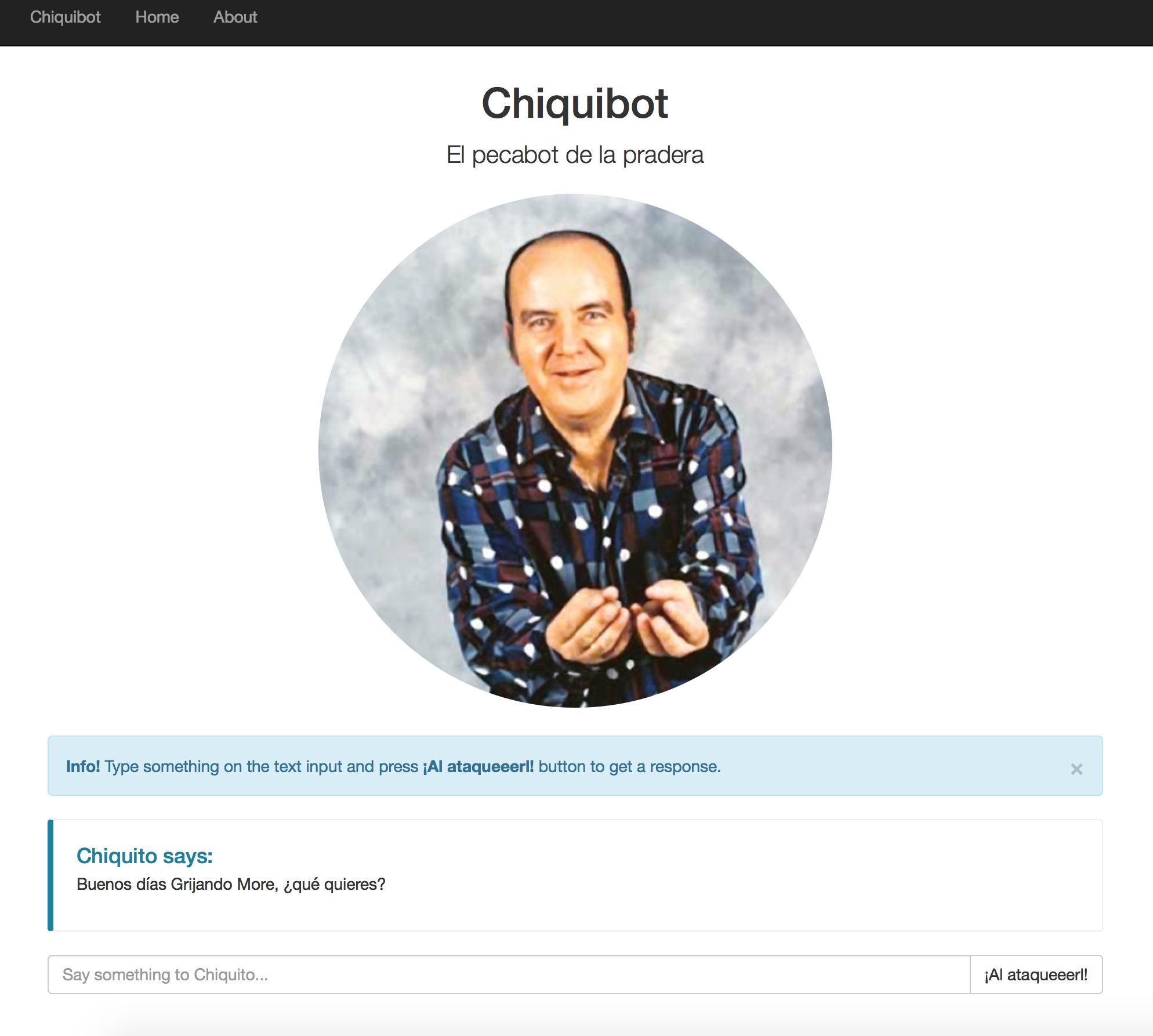- Published on
Make a conversational bot in Ruby on Rails from scratch
- Authors
- Name
- Iván González Sáiz
- @dreamingechoes
Since I began to study about artificial intelligence some years ago, one of the most interesting fields of this computer science's area for me was the automated online assistants. The first approach I found that was kind of simple was AIML, or Artificial Intelligence Markup Language. Is a XML dialect that helps you to create natural language bots, developed between 1995 and 2002.
Let's see an extremely short introduction to AIML
Because all the details about the AIML syntax and usage are properly documented on the Alicebot website, we're going to see the basis in order to be able to do our very simple first bot.
On this piece of code we have the Hello wold! of AIML (kind of):
<aiml version="1.0.1" encoding="UTF-8"?>
<category>
<pattern> HELLO MY BELOVED BOT! </pattern>
<template>
Hello my friend! :)
</template>
</category>
</aiml>
For this example, the result of the interaction with our bot will be:
User: Hello my beloved bot!
Bot: Hello my friend! :)
As you could see, matches with any XML dialect, having tags, elements and attributes.
So, let's see on detail the pieces we have on this example:
Tags
<aiml> defines the beginning and end of a AIML document.
<category> defines the unit of knowledge in bot's knowledge base.
<pattern> defines the pattern to match what a user may input to a bot.
<template> defines the response to user's input.
Elements
Both tag contents: HELLO MY BELOVED BOT! and Hello my friend! :)
Attributes
In this case we only have attributes on the aiml tag (version and encoding), but other aiml tags could have attributes as well.
AIML basic tags
Now that we have a first idea of what is AIML and his goal, for the purpose of this example we are going to see some basic tags (apart from which we had seen) which will help us to make our bot.
star
Is used to match wild card * character(s) in pattern tag.
Syntax
<star index = "n"/>
where n indicates the position of * within the user input in pattern tag.
<category>
<pattern> A * is a *. </pattern>
<template>
When a <star index="1"/> is not a <star index="2"/>?
</template>
</category>
If user enters "A mango is a fruit." then bot will respond as "When a mango is not a fruit?".
srai
Is a multipurpose tag. This tag enables AIML to define different targets for same template.
Syntax
<srai> pattern <srai/>
The commonly used terms associated with srai are:
Symbol Reduction
Divide and Conquer
Synonyms resolution
Keywords detection
Having this aiml file defined:
<category>
<pattern>WHO IS ALBERT EINSTEIN?</pattern>
<template>Albert Einstein was a german physicist.</template>
</category>
<category>
<pattern> WHO IS ISSAC NEWTON? </pattern>
<template>Issac Newton was a english physicist and mathematician.</template>
</category>
<category>
<pattern>DO YOU KNOW WHO * IS?</pattern>
<template>
<srai>WHO IS <star/></srai>
</template>
</category>
If user enters "Do you know who Albert Einstein is?" then bot will respond with the template defined on the pattern WHO IS ALBERT EINSTEIN?: "Albert Einstein was a german physicist.".
random
Is as name suggests used to get random responses. This tag enables AIML to respond differently for same input. random tag is used along with li tags. li tags carries different responses that are to be delivered to user on random basis.
Syntax
<random>
<li> pattern1 </li>
<li> pattern2 </li>
...
<li> patternN </li>
</random>
For example, consider following conversation:
Human: Hi
Robot: Hello!
Human: Hi
Robot: Hi! Nice to meet you!
Now we are ready to do our first simple bot (AIML has more tags, but for the purpose of this post, with this three tags is enough). If you want to get deeper on this, check this tutorial (in fact, the examples shown here are picked directly from there).
Ok, but... why this should be fun?
Well, apart from the fun that implies learn new things, we could do a conversational bot of anything, so let's do one with your favorite comedian. In my case, this is the Spanish comedian Chiquito de la Calzada:

Chiquito de la Calzada in all his glory. Please don't fall hypnotized by the gif, I know is hard, but let's continue.
Building a super simple Ruby on Rails app
Well, we could make the robot using the irb console to interact with it (no user interface of any kind), but as we will make the bot in Ruby, why not make a simple Rails application and give a touch of fun?
We will use one of the gems that more I love when it comes to make an application in a matter of minutes: rails apps composer.
Basically is a gem through a fairly simple question/answer process helps you create a fully functional Rails application. We will have to follow these steps:
$ mkdir myapp
$ cd myapp
$ rvm use ruby-2.2.2@myapp --ruby-version --create
$ gem install rails
$ gem install rails_apps_composer
$ gem install rvm # (only needed if creating a project-specific rvm gemset)
$ rails_apps_composer new . -r core
After answering the questions that the gem makes us, we will have our Rails application. In this case, as it is an application that will not have database or anything special, we try to specify the most basic options. In my case I chose that I would generate a Rails application example, based on bootstrap framework, with only the home and about views.
With a little CSS and some HTML we'll have a view like this (don't worry if I don't put the code in detail, at the end of the post you have a link to the repository where the final example is):

As you can see, is a very simple view: an image, an area where the bot will display the response, text input and a button to interact.
Programr, the gem that will help us to create the bot
Now we have our Rails application, let's move to manage files aiml we will generate for our bot. The aiml files alone do not result in the bot, but we need something the interpreter. In much of modern programming languages there an implementation to interpret these files (from Java to C, and of course, Ruby).
The Github user Bob Whitney has ported http://aiml-programr.rubyforge.org/ to a gem. That gem is Programr, a Ruby implementation of an interpreter for the Artificial Intelligence Markup Language.
We only have to add this gem into our Gemfile and run the bundle install command.
In the README's gem you have a simple example of usage, that I put here:
# programr_test.rb
require 'bundler'
Bundler.setup :default
require 'programr'
if ARGV.empty?
puts 'Please pass a list of AIMLs and/or directories as parameters'
puts 'Usage: ruby programr_test.rb {aimlfile|dir}[{aimlfile|dir}]...'
exit
end
robot = ProgramR::Facade.new
robot.learn(ARGV)
while true
print '>> '
s = STDIN.gets.chomp
reaction = robot.get_reaction(s)
STDOUT.puts "<< #{reaction}"
end
robot = ProgramR::Facade.new returns us an instance of ProgramR::Facade model. ARGV contains (or should contain if we pass the info properly), the aiml file or folder that contains the list of aiml files of our bot.
robot.learn(ARGV) parse the aiml files and keep in memory all the information for manage the bot conversation.
reaction = robot.get_reaction(s) sends to the bot an entry (s contains the user message), match the user message with any of the bot patterns, and returns a response as result. Very simple and easy to understand. Let's integrate Programr with our Rails app!
First of all, create a folder in lib directory with the name of your bot (in my case, chiquibot) and put there all your aiml files. Then create a new initializer to load all the information:
require 'programr'
brains = Dir.glob("lib/chiquibot/*")
CHIQUIBOT = ProgramR::Facade.new
CHIQUIBOT.learn(brains)
At the end we'll have something like this:
.
+-- app
+-- bin
+-- config
| +-- initializers
| +-- chiquibot.rb
+-- db
+-- lib
| +-- chiquibot
| +-- chiquibot.aiml
| +-- ...
+-- log
+-- public
| ...
This will load the aiml files when the Rails server starts. The next step is create an action on ApplicationController we could call via Ajax to get the bot response. Simply add this code into the controller:
class ApplicationController < ActionController::Base
protect_from_forgery with: :exception
def ask_chiquito
reaction = CHIQUIBOT.get_reaction(params[:query])
render json: { response: reaction.present? ? reaction : '¿Comorl?' }
end
end
and then add the route on routes.rb file:
get 'ask_chiquito', to: 'application#ask_chiquito'
Ok! We're almost done! Now the only thing we have to do is code some JS in order to do the Ajax call to our action. Let's do it simple, adding this few lines of code into our application.js:
$(document).ready(function () {
$('#al-ataquerl').on('click', function (event) {
$.ajax({
url: '/ask_chiquito',
type: 'json',
method: 'get',
data: { query: $('#query').val() },
success: function (data) {
$('.chiquibot-response').removeClass('hide')
$('#chiquito-response').html(data['response'])
$('#query').val('')
},
})
})
})
As you can see, on the click event hover the button with ID #al-ataquerl we do an ajax request to the url of our action, with the content of the input with ID #query as query. Finally on success, we update the div with ID #chiquito-response changing his html content with the one stored on data['response']. Simple as that!
Now if you send some message that matches with any of the patterns you have stored on your aiml files, you should see something like this:

In my case, I have done a very very simple aiml file with a few sentences as an example, but I encourage you to do the smartest bot ever made! Here is my aiml file:
<?xml version="1.0" encoding="UTF-8"?>
<aiml version="1.0">
<category>
<pattern>HOLA *</pattern>
<template>
Buenos días Grijando More, ¿qué quieres?
</template>
</category>
<category>
<pattern>ADIOS *</pattern>
<template>
¡Hasta luego Lucaaaaaas!
</template>
</category>
<category>
<pattern>CHIQUITO *</pattern>
<template>
<random>
<li>¿Qué quieres, pecador de la pradera?</li>
<li>¡Jaaaaaaaaarl!, ¡Qué dise tu!</li>
</random>
</template>
</category>
<category>
<pattern>* CHISTE</pattern>
<template>
<random>
<li>
Dos amigos:
- Oye, pues mi hijo en su nuevo trabajo se siente como pez en el agua.
- ¿Qué hace?
- Nadaaaaaaarl
</li>
<li>
- Mi amor, estoy embarazada. ¿Qué te gustaría que fuera?
- ¿Una bromaaaaarl?
</li>
<li>
- ¿Por qué se suicidó el libro de matemáticas?.
- Porque tenia muchos problemas, ¡cobarde!
</li>
</random>
</template>
</category>
<category>
<pattern>* CONSEJO</pattern>
<template>
<random>
<li>¡Ten cuidadínnn no te hagas pupita en el fistro duodenalll!</li>
<li>Relájate físicamente, morálmente</li>
<li>¡Relájese usterl!</li>
</random>
</template>
</category>
<category>
<pattern>* FRASES</pattern>
<template>
<random>
<li>¡Trabaja menos que el sastre de Tarzán!</li>
<li>¡Eres más peligroso que un tiroteo en un ascensooooorl!</li>
<li>¡No puedo, no puedooooorl!</li>
</random>
</template>
</category>
<category>
<pattern>CANTA *</pattern>
<template>
<random>
<li>¡Sieteee caballo que vienennn de Bonanzaaarrlll!</li>
<li>¡Lo maté en agosto, la calóh apretabaaaaaa!</li>
</random>
</template>
</category>
</aiml>
Any place where I can see the result?
Yeah! Here you have the Github repo for this example, so you can clone it, change it, play with it... whatever you want! 😄
I hope you like this post and helps you to do the first step to immerse you into AI. And please, keep in mind this precious words from Chiquito de la Calzada:
¡No te digo trigo por no llamarte Rodrigoooooooorl!
Enjoyed this article?
Stay in the loop
Get notified when I publish new articles about engineering leadership, remote teams, and building better tech cultures. No spam, unsubscribe anytime.